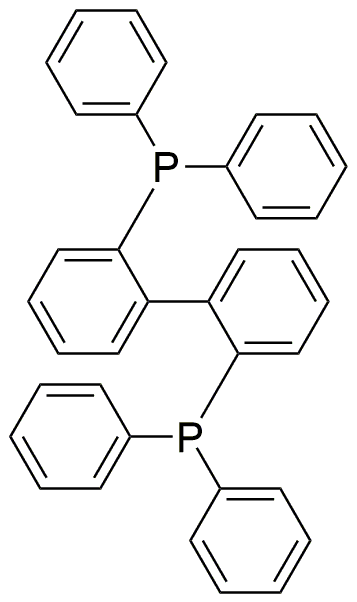2,2'-Bis(diphenylphosphino)biphenyl is widely utilized in research focused on:
- Catalysis: This compound serves as a highly effective ligand in various catalytic processes, particularly in cross-coupling reactions. Its ability to stabilize transition metals enhances reaction efficiency, making it valuable in the pharmaceutical and materials industries.
- Organometallic Chemistry: It is commonly used in the synthesis of organometallic complexes, which are crucial for developing new materials and chemicals. Researchers benefit from its unique properties that facilitate the formation of stable complexes.
- Phosphine Ligands: As a phosphine ligand, it plays a significant role in asymmetric synthesis, aiding in the production of chiral compounds. This is particularly important in the production of fine chemicals and agrochemicals.
- Research in Coordination Chemistry: The compound is utilized in studies involving coordination compounds, helping scientists understand metal-ligand interactions. This knowledge is essential for designing new catalysts and materials.
- Environmental Applications: It has potential applications in environmental chemistry, particularly in the development of processes for pollutant degradation, showcasing its versatility beyond traditional uses.
General Information
Properties
Safety and Regulations
Applications
2,2'-Bis(diphenylphosphino)biphenyl is widely utilized in research focused on:
- Catalysis: This compound serves as a highly effective ligand in various catalytic processes, particularly in cross-coupling reactions. Its ability to stabilize transition metals enhances reaction efficiency, making it valuable in the pharmaceutical and materials industries.
- Organometallic Chemistry: It is commonly used in the synthesis of organometallic complexes, which are crucial for developing new materials and chemicals. Researchers benefit from its unique properties that facilitate the formation of stable complexes.
- Phosphine Ligands: As a phosphine ligand, it plays a significant role in asymmetric synthesis, aiding in the production of chiral compounds. This is particularly important in the production of fine chemicals and agrochemicals.
- Research in Coordination Chemistry: The compound is utilized in studies involving coordination compounds, helping scientists understand metal-ligand interactions. This knowledge is essential for designing new catalysts and materials.
- Environmental Applications: It has potential applications in environmental chemistry, particularly in the development of processes for pollutant degradation, showcasing its versatility beyond traditional uses.
Documents
Safety Data Sheets (SDS)
The SDS provides comprehensive safety information on handling, storage, and disposal of the product.
Product Specification (PS)
The PS provides a comprehensive breakdown of the product’s properties, including chemical composition, physical state, purity, and storage requirements. It also details acceptable quality ranges and the product's intended applications.
Certificates of Analysis (COA)
Search for Certificates of Analysis (COA) by entering the products Lot Number. Lot and Batch Numbers can be found on a product’s label following the words ‘Lot’ or ‘Batch’.
*Catalog Number
*Lot Number
Certificates Of Origin (COO)
This COO confirms the country where the product was manufactured, and also details the materials and components used in it and whether it is derived from natural, synthetic, or other specific sources. This certificate may be required for customs, trade, and regulatory compliance.
*Catalog Number
*Lot Number
Safety Data Sheets (SDS)
The SDS provides comprehensive safety information on handling, storage, and disposal of the product.
DownloadProduct Specification (PS)
The PS provides a comprehensive breakdown of the product’s properties, including chemical composition, physical state, purity, and storage requirements. It also details acceptable quality ranges and the product's intended applications.
DownloadCertificates of Analysis (COA)
Search for Certificates of Analysis (COA) by entering the products Lot Number. Lot and Batch Numbers can be found on a product’s label following the words ‘Lot’ or ‘Batch’.
*Catalog Number
*Lot Number
Certificates Of Origin (COO)
This COO confirms the country where the product was manufactured, and also details the materials and components used in it and whether it is derived from natural, synthetic, or other specific sources. This certificate may be required for customs, trade, and regulatory compliance.


